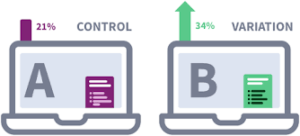19/04/2022
By Imran M
By Imran M
In today’s competitive online marketplace, businesses must constantly evolve to maintain their edge. One crucial area of improvement is conversion rate optimization, a vital process in enhancing user experiences and driving revenue growth. Fast-growing companies can greatly benefit from implementing conversion rate optimization best practices to maximize their digital performance. Understanding the importance of conversion rate optimization best practices is essential for driving your organization’s digital performance. By investing time and resources in CRO, you will not only enhance your online presence but also create a more engaging and user-friendly experience for your customers. This, in turn, will lead to increased brand loyalty, higher customer satisfaction and ultimately, a stronger bottom line. Here we will outline the key conversion rate optimization best practices, providing insights into how to help you and your organization achieve higher online success.

Before embarking on any CRO strategy, it’s crucial to identify and prioritize your organization’s conversion goals. These can include increasing email sign-ups, boosting product sales, or enhancing user engagement with content. By clearly defining and prioritizing your objectives, you can create targeted optimization strategies that align with your company’s overall business goals.
A data-driven approach is essential when implementing conversion rate optimization best practices. Analyzing user behaviour, bounce rates and engagement metrics can help identify potential areas of improvement. Utilize tools like Google Analytics, heatmaps and session recordings to gather insights into how users interact with your website. This information can reveal pain points, friction areas and opportunities for enhancement.
A/B testing is a vital component of CRO. By comparing two variations of a webpage, email, or other marketing material, you can determine which version performs better in terms of conversions. Continuously running A/B tests allows you to optimize your website and marketing efforts based on empirical data, rather than intuition or personal preferences. By refining elements such as headlines, images, calls-to-action and landing page layouts, you can maximize the chances of conversion. VWO is one of the finest and most hassle-free product used in enterprise projects. You can understand visitor behaviour, run experiments and re-engage your visitors to become lifelong customers and advocates of your brand.
A seamless user experience is crucial for driving conversions. Assess your website’s navigation, content and overall design to ensure it’s intuitive and user-friendly. Key components to consider include:
Mobile responsiveness: Ensure your website is optimized for mobile devices, as a significant portion of online traffic now comes from smartphones and tablets.
Loading times: Fast-loading websites lead to higher user engagement and reduced bounce rates. Optimize your site’s performance by compressing images, minimizing HTTP requests and leveraging browser caching.
Clear calls-to-action (CTAs): Make sure your CTAs are prominent, easy to understand and compelling to encourage users to take the desired action.
Personalization is a powerful tool for enhancing user experiences and increasing conversions. By tailoring content, offers, and messaging to individual users based on their preferences, browsing history and demographics, you can create a more engaging and relevant experience. Utilize data collected through cookies, CRM systems and third-party tools to segment your audience and deliver customized content.
Conversion rate optimization is an ongoing process. Continuously monitor your website’s performance, analyze the results and make data-driven decisions to improve and optimize your strategies. This iterative approach ensures you stay agile and responsive to changing user needs and market conditions.
Implementing conversion rate optimization best practices is crucial to driving growth and enhancing the organization’s digital performance. By defining and prioritizing conversion goals, analyzing data and user behaviour, conducting A/B testing, streamlining the user experience, personalizing the user journey and continuously monitoring and iterating your strategies, you can significantly improve your online presence and drive greater results. In a constantly evolving digital landscape, staying ahead of the curve and maximizing your online potential is more important than ever. By implementing conversion rate optimization best practices and adapting to the changing needs of your audience, you can ensure your organization remains competitive and continues to thrive in an increasingly digital world.